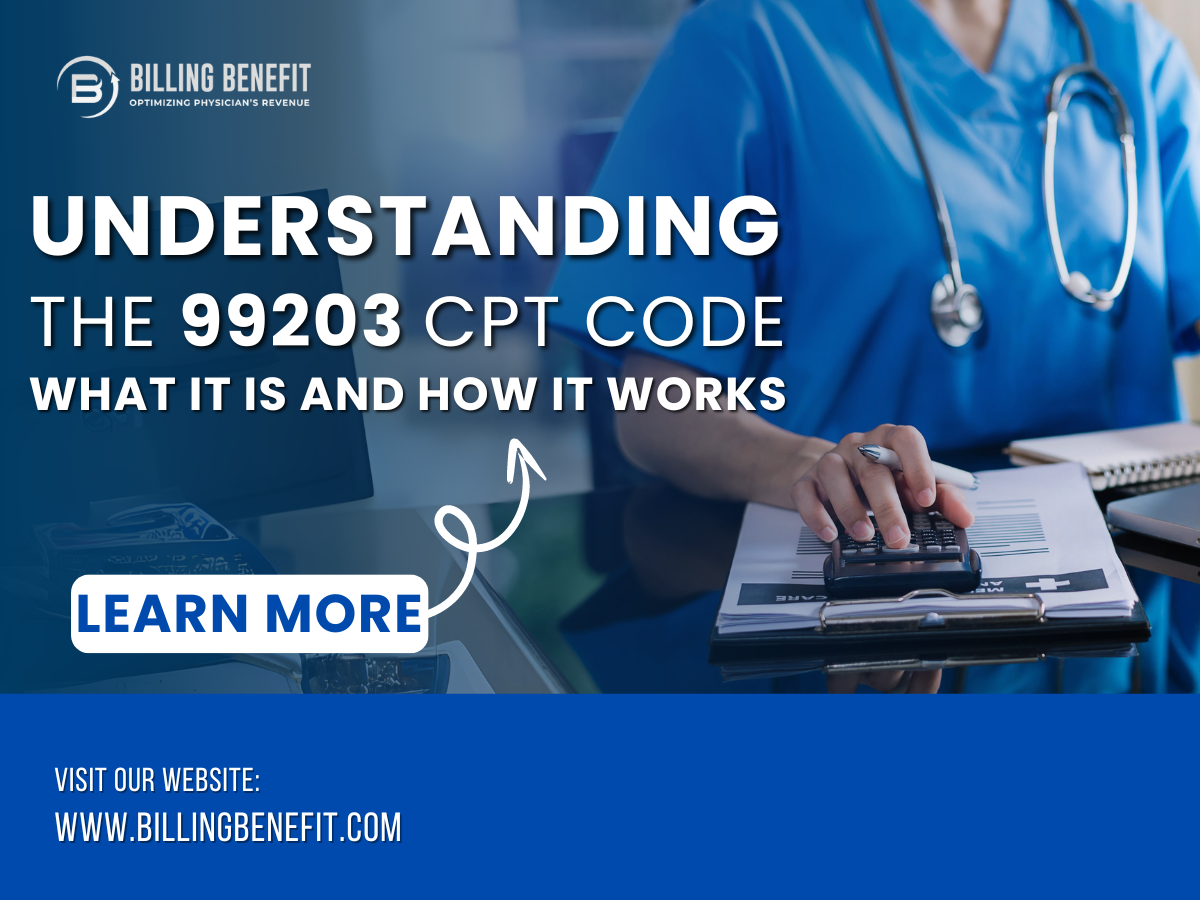Navigating the world of medical billing and coding can be a challenge, especially when it comes to understanding specific codes like the 99203 CPT code. Designed for medical professionals, healthcare administrators, and billing specialists, this guide dives into everything you need to know about CPT code 99203, its usage, requirements, and common billing practices. Whether you’re new to coding or looking to refine your skills, understanding this code is key to ensuring accuracy in patient records and reimbursement claims.
What Is the 99203 CPT Code?
The 99203 CPT code belongs to the Current Procedural Terminology (CPT) system, which is used to document medical, surgical, and diagnostic services. Specifically, 99203 is used for outpatient visits involving new patients. It represents an evaluation and management (E/M) service for a new patient that requires a moderate level of complexity in terms of decision-making, history, and examination.
In simpler terms, 99203 refers to a moderate-level office visit for new patients, where the physician or healthcare provider spends a considerable amount of time assessing the patient’s condition.
CPT Code 99203 Requirements: What You Need to Know
Before using the 99203 CPT code for billing, it’s crucial to understand the requirements for using this code correctly. Three key components must be present in the visit to justify using 99203:
- History: The patient must have a detailed history taken, which includes medical, family, and social aspects. This allows the healthcare provider to get a broad understanding of the patient’s condition.
- Examination: A moderate-level physical exam is necessary. The examination should focus on addressing the patient’s chief complaint and any related concerns.
- Medical Decision Making (MDM): The decision-making process involved in diagnosing and treating the patient should be of moderate complexity. This typically includes evaluating multiple potential diagnoses or treatment options.
Meeting these requirements ensures that the CPT code 99203 is used appropriately, preventing errors in billing or claims denials.
How Much Time Does 99203 CPT Code Cover?
Another important aspect of the 99203 CPT code is the amount of time spent with the patient. According to the American Medical Association (AMA) guidelines, an outpatient visit billed under 99203 generally involves about 30 minutes of face-to-face time with the patient.
This time estimate serves as a guideline and can vary depending on the complexity of the visit. However, ensuring that the time spent aligns with the code’s requirements is essential for proper reimbursement.
How Does 99203 Compare to Other CPT Codes?
Medical coding can be confusing, especially when it comes to distinguishing between different levels of service. 99203 is part of a series of codes used for new patient office visits, each indicating a different level of complexity and time commitment:
- 99201: Represents a straightforward visit with minimal complexity. This code is used for short, problem-focused visits.
- 99202: Slightly more detailed than 99201, involving a low level of complexity and time (around 20 minutes).
- 99204: A higher level of complexity than 99203, involving 45 minutes of face-to-face time with the patient.
- 99205: Represents the most complex new patient visit, requiring an extensive amount of time (around 60 minutes) and a very high level of medical decision-making.
Using the correct CPT code is vital for accurate billing. 99203 is commonly used for moderate-level new patient visits where the situation requires more than a brief examination but doesn’t involve extensive time or complex decision-making like 99204 or 99205.
Common Mistakes When Using the 99203 CPT Code
Even experienced medical billers and coders can make mistakes when assigning the 99203 CPT code. Some of the most frequent errors include:
- Under-Coding: This happens when a healthcare provider undervalues the level of service provided. In other words, the patient visit is billed under a code that reflects a lower level of complexity than what was actually required. Under-coding can result in revenue loss for the provider.
- Over-Coding: On the flip side, over-coding involves billing for a more complex service than was actually provided. This can lead to audits and even fines for the healthcare practice if done frequently.
- Inadequate Documentation: For billing purposes, every detail of the visit must be documented correctly. If there is insufficient documentation to support the complexity required by the 99203 CPT code, the claim may be denied.
Avoiding these mistakes is essential for accurate billing, ensuring that healthcare providers are compensated fairly for their services and preventing unnecessary audits.
Billing Tips for the 99203 CPT Code
Correct billing practices can streamline the reimbursement process for healthcare providers. Here are some tips to keep in mind when billing under the 99203 CPT code:
- Ensure Detailed Documentation: All aspects of the patient’s visit, including their history, examination, and decision-making process, should be well-documented in the patient’s records.
- Use Electronic Health Records (EHRs): Leveraging EHRs can simplify the coding process, as most systems will automatically suggest the correct CPT code based on the inputted information.
- Keep Up With Coding Updates: The CPT system is updated regularly, and it’s important to stay informed of any changes that might affect the billing of 99203 or similar codes.
- Cross-Check With Payers: Different insurance companies may have specific guidelines on how the 99203 CPT code should be used. Always verify these guidelines to prevent claim rejections.
By following these best practices, healthcare providers can maximize their reimbursement and avoid unnecessary claim denials.
When to Use the 99203 CPT Code
Understanding when to use the 99203 CPT code is crucial. It is best suited for:
- New patients who have never been seen before or haven’t been seen by the provider in the past three years.
- Moderate complexity visits involving multiple diagnoses or a more thorough evaluation than a brief check-up.
- Preventive care visits where the provider conducts a detailed assessment to identify any potential health risks or concerns.
In contrast, 99203 should not be used for visits that involve minimal decision-making, quick consultations, or follow-up visits with existing patients.
The Impact of Proper Coding on Healthcare Revenue
Accurate coding, especially when using codes like 99203, plays a significant role in the financial health of medical practices. Proper coding ensures that healthcare providers are paid fairly for their services, reducing the risk of claim rejections, audits, and fines.
By investing in coding training and ensuring that staff are familiar with the nuances of codes like 99203, practices can see an improvement in revenue and a reduction in administrative headaches.
FAQs
Q. What does CPT code 99203 stand for?
A. CPT code 99203 refers to a moderate-complexity outpatient office visit for new patients.
Q. What are the requirements for using CPT code 99203?
A. The visit must involve a detailed history, a moderate-level physical exam, and moderate complexity in medical decision-making.
Q. How much time is associated with CPT code 99203?
A. Generally, about 30 minutes of face-to-face time with the patient.
Q. Can 99203 be used for existing patients?
A. No, 99203 is specifically for new patients. For established patients, different codes (e.g., 99213, 99214) are used.
Q. What’s the difference between 99203 and 99204?
A. The primary difference is the complexity and time. 99204 involves more complex decision-making and around 45 minutes of time.
Q. How can I avoid billing errors with CPT 99203?
A. Ensure proper documentation, keep up-to-date with coding changes, and avoid over- or under-coding.
Conclusion
Mastering the 99203 CPT is essential for accurate medical billing and coding. By understanding the requirements, time involved, and common mistakes, healthcare providers can use this code effectively. This not only ensures accurate reimbursement but also contributes to the overall efficiency of the healthcare system.










